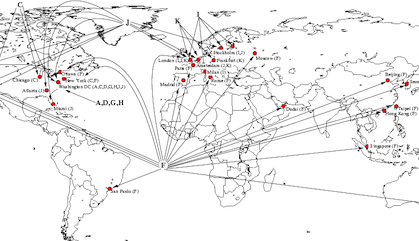Domain Name System Is Opening Up Space for .Whatever
January 11, 2012
on
on

The Domain Name System (DNS) is about to undergo the biggest alteration since its introduction in 1985. Up until now there has been a limited amount of Top Level Domains (TLDs). But from the 12th of January there is a three-month time window in which anyone can apply for any TLD.
The Internet’s DNS translates the numerical IP addresses by which computers find each other into domain names which are easier to remember for people. So 192.0.32.10 translates to www.example.com. The TLD in this case is ‘com’ and ‘example’ the second level domain, separated by a dot.
Up until now only a limited amount of TLDs was created by ICANN, the non-profit corporation which coordinates the DNS.
Initially 7 generic TLDs (gTLDs) were created (.com, .edu, .gov, .int, .mil, .net, and .org). Three of these were free to anyone who wanted to register a domain. The other 4 were restricted to particular use. For instance, the .int TLD is for organizations which are established through international treaties and .mil is for the US military. Besides the gTLDs there are about 250 country-code TLDs (ccTLDs) such as .JP .BE .ZA.
Early 2000’s, after long debate, ICANN created 13 more TLD’s some open (.biz, .info) and some restricted (.jobs, .travel).
After nearly thirty years of doing with no more than 22 gTLDs, ICANN is opening the doors to anyone who wishes to operate a TLD. The application window is open from January 12 until April 12. But this limitation is put in place for procedural reasons only, if there is a lot of interest another application round can be organized in 3 or 5 years. ICANN intends to open up TLD registration for good.
The process takes a long time. It will be 2013 earliest before the new TLDs will appear on the net.
Rod Beckstrom, president of ICANN, told Wired reporter John C. Abell why, if ICANN intends to democratize the DNS, the process of registering is so slow: “The commitment that we’ve made to the global community to ensure the security and stability of the internet is to run the process at a maximum rate of a thousand new top level domains per year.”
Anyone can register a TLD, yes, but nobody said it would be easy. Or cheap. Operating a TLD is not quite the same as registering a second level domain. It is the responsibility of the TLD operator that domain technically functions. It also costs a lot of money to operate a piece of internet infrastructure. The ICANN application fee alone is $185.000
The ICANN video below is intended to help you decide whether to apply or not.
Image: Location of DNS root servers, including anycast nodes, identified by their one-letter names.
Source: Caida.org
More info on ICANN and TLD’s Icann.org
The Internet’s DNS translates the numerical IP addresses by which computers find each other into domain names which are easier to remember for people. So 192.0.32.10 translates to www.example.com. The TLD in this case is ‘com’ and ‘example’ the second level domain, separated by a dot.
Up until now only a limited amount of TLDs was created by ICANN, the non-profit corporation which coordinates the DNS.
Initially 7 generic TLDs (gTLDs) were created (.com, .edu, .gov, .int, .mil, .net, and .org). Three of these were free to anyone who wanted to register a domain. The other 4 were restricted to particular use. For instance, the .int TLD is for organizations which are established through international treaties and .mil is for the US military. Besides the gTLDs there are about 250 country-code TLDs (ccTLDs) such as .JP .BE .ZA.
Early 2000’s, after long debate, ICANN created 13 more TLD’s some open (.biz, .info) and some restricted (.jobs, .travel).
After nearly thirty years of doing with no more than 22 gTLDs, ICANN is opening the doors to anyone who wishes to operate a TLD. The application window is open from January 12 until April 12. But this limitation is put in place for procedural reasons only, if there is a lot of interest another application round can be organized in 3 or 5 years. ICANN intends to open up TLD registration for good.
The process takes a long time. It will be 2013 earliest before the new TLDs will appear on the net.
Rod Beckstrom, president of ICANN, told Wired reporter John C. Abell why, if ICANN intends to democratize the DNS, the process of registering is so slow: “The commitment that we’ve made to the global community to ensure the security and stability of the internet is to run the process at a maximum rate of a thousand new top level domains per year.”
Anyone can register a TLD, yes, but nobody said it would be easy. Or cheap. Operating a TLD is not quite the same as registering a second level domain. It is the responsibility of the TLD operator that domain technically functions. It also costs a lot of money to operate a piece of internet infrastructure. The ICANN application fee alone is $185.000
The ICANN video below is intended to help you decide whether to apply or not.
Image: Location of DNS root servers, including anycast nodes, identified by their one-letter names.
Source: Caida.org
More info on ICANN and TLD’s Icann.org
Read full article
Hide full article



Discussion (0 comments)